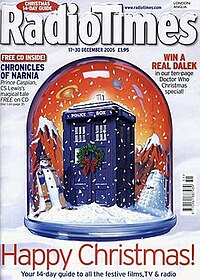RadioTimes

Christmas 2005 double issue
|
|
| Editor | Ben Preston |
|---|---|
| Categories | TV and radio listings |
| Frequency | Weekly |
| Circulation | 684,922 (January – Dec 2016) |
| First issue | 28 September 1923 |
| Company |
Immediate Media Company (2011–) BBC Magazines (1923–2011) |
| Country | United Kingdom |
| Based in | London |
| Language | British English |
| Website | radiotimes |
| ISSN | 0033-8060 |
Radio Times is a British weekly television and radio programme listings magazine. It was the world's first broadcast listings magazine when it was founded in 1923 by John Reith, the then general manager of the BBC. It was published entirely in-house by BBC Magazines from 1937 until 2011 when the BBC Magazines division was merged into Immediate Media Company.
Radio Times was first issued on 28 September 1923, carrying details of BBC radio programmes (newspapers at the time boycotted radio listings, fearing that increased listenership might decrease their sales).
Initially, Radio Times was a combined enterprise between the BBC and the publisher George Newnes, who type-set, printed and distributed the magazine. But in 1925 the BBC assumed full editorial control, and by 1937 the publication was fully in-house. The Radio Times established a reputation for using leading writers and illustrators, and the covers from the special editions are now collectible design classics.
In 1928, Radio Times announced a regular series of ‘experimental television transmissions by the Baird process' for half an hour every morning. The launch of the first regular 405-line television service by the BBC was reflected with television listings in the Radio Times edition of 23 October 1936. Thus Radio Times became the first television listings magazine in the world. Initially only two pages in each edition were devoted to television. However, in January 1937 the magazine published a lavish photogravure supplement and by September 1939, there were three pages of television listings.
Britain declared war on Germany on 3 September 1939 and television broadcasting ceased. Radio listings continued throughout the war for a reduced service, but by 1944, paper rationing meant editions were only 20 pages of tiny print on thin paper.
After the war television resumed and the Radio Times expanded too. Regional editions were introduced. In 1953 the television listings, which so far had been in the back of the magazine, were alongside the daily radio schedules. During the mid-50s Radio Times covers featured television rather than radio more and more, and in 1957 television listings were moved to a separate section at the front; radio listings were relegated to the back.
By the 1950s Radio Times had grown to be the magazine with the largest circulation in Europe, with an average sales of 8.8 million in 1955.
...
Wikipedia
